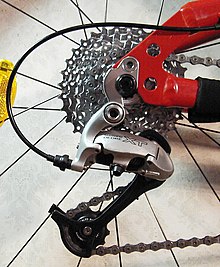Our website is made possible by displaying online advertisements to our visitors.
Please consider supporting us by disabling your ad blocker.
Bicycle gearing



Bicycle gearing is the aspect of a bicycle drivetrain that determines the relation between the cadence, the rate at which the rider pedals, and the rate at which the drive wheel turns.
On some bicycles there is only one gear and, therefore, the gear ratio is fixed, but most modern bicycles have multiple gears and thus multiple gear ratios. A shifting mechanism allows selection of the appropriate gear ratio for efficiency or comfort under the prevailing circumstances: for example, it may be comfortable to use a high gear when cycling downhill, a medium gear when cycling on a flat road, and a low gear when cycling uphill. Different gear ratios and gear ranges are appropriate for different people and styles of cycling.
A cyclist's legs produce power optimally within a narrow pedalling speed range, or cadence. Gearing can be optimized to use this narrow range as efficiently as possible. As in other types of transmissions, the gear ratio is closely related to the mechanical advantage of the drivetrain of the bicycle. On single-speed bicycles and multi-speed bicycles using derailleur gears, the gear ratio depends on the ratio of the number of teeth on the crankset to the number of teeth on the rear sprocket (cogset). For bicycles equipped with hub gears, the gear ratio also depends on the internal planetary gears within the hub. For a shaft-driven bicycle the gear ratio depends on the bevel gears used at each end of the shaft.
For a bicycle to travel at the same speed, using a lower gear (larger mechanical advantage) requires the rider to pedal at a faster cadence, but with less force. Conversely, a higher gear (smaller mechanical advantage) provides a higher speed for a given cadence, but requires the rider to exert greater force or stand while pedalling. Different cyclists may have different preferences for cadence, riding position, and pedalling force. Prolonged exertion of too much force in too high a gear at too low a cadence can increase the chance of knee damage;[1] cadence above 100 rpm becomes less effective after short bursts, as during a sprint.[1]
- ^ a b Ed Pavelka (1999). Bicycling magazine's training techniques for cyclists: greater power, faster. Rodale, Inc. pp. 4–5. ISBN 9781579541682.
There are lots of cyclists who have suffered debilitating trauma from pushing too big a gear....benefits of spinning begin to disappear above 100 rpm.
Previous Page Next Page


